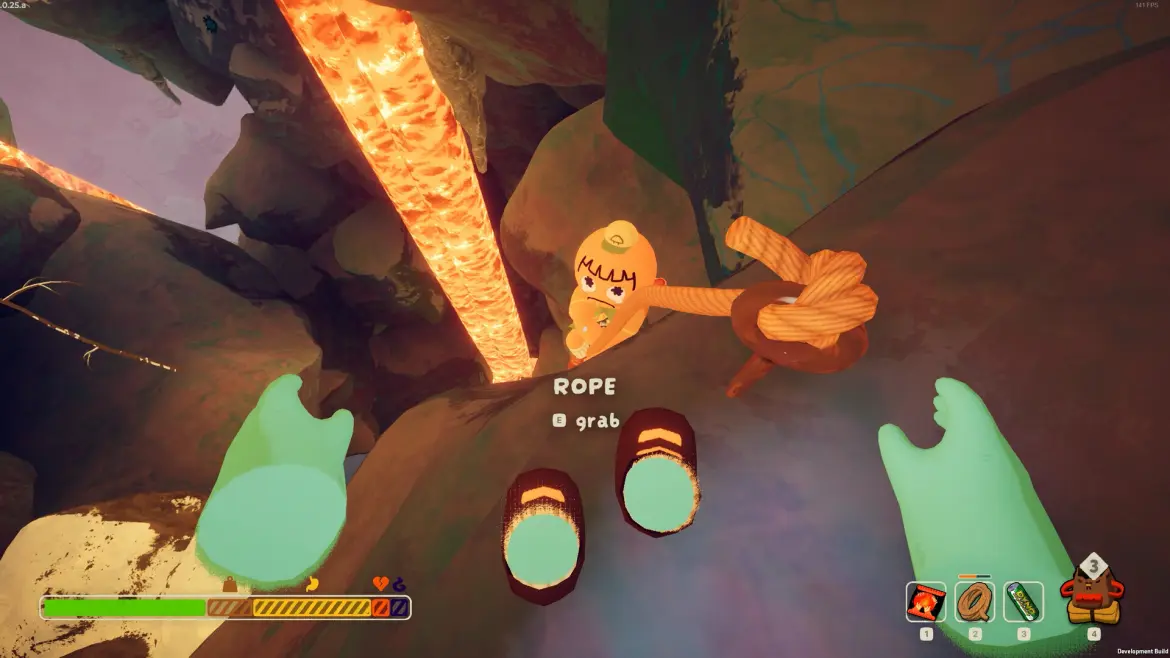The allure of climbing games is undeniable, captivating players with the thrill of vertical ascent and the challenge of conquering daunting heights.
Each title in this niche genre strives to offer a distinct experience, ranging from hyper-realistic simulations to whimsical, fantastical interpretations. Some focus on the sheer joy of breathtaking vistas, while others immerse players in the tactile details of handholds and foot placements. The recent indie release, Peak, carves out its own unique identity, blending elements of fantasy with a refreshing simplicity. It strips away many of the complex affectations found in other climbing games, yet paradoxically, this streamlined approach makes the gameplay simultaneously both easier to grasp and more difficult to master, creating a truly engaging and often humorous adventure.
Peak quickly reveals its intended design as a cooperative experience, ideally played with friends. However, its charm and challenge also extend to solo play, as highlighted by praise from gaming publications like Eurogamer. The game’s narrative begins dramatically: your plane crashes on a mysterious, vibrant island. Your objective is clear – climb from the sandy beach to a visible plume of smoke emanating from the top of a towering mountain. When playing with companions, this journey could easily transform into a hilarious escapade or a test of treacherous loyalty, with opportunities for boosts and strategic teamwork.
Yet, tackling it alone initially presented a formidable challenge. Managing the character’s weight and stamina felt particularly arduous without a partner to share the burden of gear or assist in scaling lengthy rock faces. This often necessitated extensive circling of the mountain, diligently searching for shorter, more manageable climbs. Nevertheless, with persistence, the game’s rhythm clicked, allowing solo progress to the mountain’s summit and unlocking new, increasingly demanding areas to scale.
Unique Mechanics: Stamina and Simplicity
Peak redefines climbing mechanics by simplifying movement while deepening the strategic importance of a single, crucial resource: stamina.
Streamlined Movement, Complex Stamina
Peak distinguishes itself with a refreshingly straightforward approach to its core climbing mechanics. Unlike many climbing games that demand precise handhold detection or intricate route planning, Peak allows players to basically climb anything simply by pressing a button to attach to it. This intuitive “stick-to-surface” mechanic significantly lowers the barrier to entry, making the act of climbing feel fluid and accessible. It frees players from pixel-perfect precision, allowing them to focus on the broader strategy of ascent.
However, this apparent ease is masterfully balanced and made significantly more complicated by the game’s ingenious stamina bar. In Peak, stamina is not merely one of several meters to manage; it is the entire deciding factor in how far you can climb. You possess just this one single bar, and its availability is constantly impacted by various factors. These factors “take chunks out of it,” demanding constant vigilance and strategic thinking. For instance, how much stuff is in your backpack directly influences your available stamina, making inventory management a critical component of successful climbing.
Being hungry will also reduce your stamina, emphasizing the importance of foraging and food consumption. Furthermore, getting injured will visibly deplete your stamina, introducing an element of risk and consequence for navigating environmental hazards. Each of these influencing factors – weight, hunger, and injury – is clearly represented by its own distinct color and symbol on the stamina bar. This intuitive visual feedback makes it exceptionally easy for players to understand precisely why their whole stamina bar isn’t available, providing immediate clarity on the underlying mechanics governing their climbing capacity.
The Intricacies of Resource Management
While understanding why your stamina is limited is straightforward in Peak, figuring out what you’re supposed to do about it is where a significant portion of the game’s engaging challenge and fun truly lies. The developers intentionally make solutions less obvious, forcing players into experimentation and strategic decision-making. Dealing with hunger, in particular, presents a surprisingly complex and often humorous mini-game within the larger climbing adventure.
Beyond the convenience of packaged food that can be found in suitcases scattered around the world, the game encourages exploration for natural sustenance. The environment is replete with edible plants and fruits. While these natural resources will undeniably address your hunger and restore some stamina, they come with a hidden caveat: they also possess unforeseen or hidden effects.
This element of discovery introduces a layer of delightful unpredictability. During a solo play session, desperate for food to regain precious stamina and continue climbing, players might make impulsive choices. For instance, in a moment of hunger, one might unknowingly worsen their situation by deciding to carry heavy coconut halves, the added weight further taxing their already depleted stamina.
Or, more dangerously, one could poison themselves with mysterious berries, leading to negative status effects that further impede progress or even cause a tumble to their demise. Conversely, other foods may have unexpected positive effects, rewarding brave experimentation. The brilliant twist is that when encountering a food item for the first time, there is no way to know what it will do except to try it out. This trial-and-error approach transforms every foraging decision into a careful balancing act of risk versus reward, adding a layer of strategic depth and often comedic consequence to Peak’s unique climbing mechanics.
Environmental Challenges and Evolving Landscapes
Peak’s world is not static; it’s dynamic and fraught with environmental hazards, demanding constant adaptation and strategic thinking.
Navigating Perilous Environments
The vibrant world of Peak is not merely a beautiful backdrop for climbing; it’s an active participant in the gameplay, presenting players with a variety of environmental hazards that demand constant vigilance and quick thinking. From the very first level, players learn to navigate treacherous terrain. For instance, when climbing near the beach, one must be exceedingly careful to scoot around jellyfish if they aren’t paying attention. Slipping on these seemingly innocuous obstacles can lead to a fall, potentially depleting precious stamina or even resulting in a painful tumble. This subtle yet effective hazard introduces players to the game’s unforgiving nature early on.
As players progress to the second mountain, the environmental challenges escalate dramatically. This new area is a dense jungle slope, replete with persistent rain and thorny vines, each element designed to impede progress and test resilience. The rain reduces visibility and perhaps grip, while the vines can snag and injure. During one particularly memorable encounter in this new biome, a player might inadvertently wander into “something” mysterious.
This could be an unseen plant, a hidden creature, or a sudden environmental trap. The game visually communicates the immediate danger: the screen might suddenly turn purple, and a poison meter might shoot up, indicating a rapid and severe negative effect. Such encounters often lead to inevitable consequences, with the afflicted character tumbling to their death, reinforcing the game’s emphasis on careful exploration and risk assessment.
Dynamic Mountains and Constant Discovery
Adding another layer of unpredictability and replayability, the mountains in Peak are designed to change on regular intervals. This dynamic element ensures that each climbing session, even in areas previously explored, can present new challenges and discoveries. While extensive play might eventually undo the mystery of these hazards, allowing seasoned players to anticipate and avoid known dangers, the inherent variability ensures that there are still new things to discover and overcome. This procedural generation or periodic refreshing of environmental elements keeps the game fresh and prevents it from becoming stale, even after multiple playthroughs.
The dynamic nature of the environments encourages continuous learning and adaptation. Players cannot simply memorize optimal routes; they must remain agile in their decision-making, constantly assessing new risks and opportunities presented by the evolving landscape. This design choice prevents a “brute force” approach, where players simply try to power through climbs. Instead, it fosters a more thoughtful, exploratory playstyle. The interaction between the constant environmental threats and the ever-present stamina management system ensures that every climb, every decision about foraging for food, and every step taken is imbued with a sense of tension and strategic importance, making the journey to the peak a continuously engaging and unpredictable adventure.
Solo Play: A Rewarding, Strategic Grind
While designed for co-op, Peak’s solo experience transforms into a unique, exploratory puzzle.
Embracing Strategic Ascent
When played alone, Peak can initially feel daunting, particularly when a series of unfortunate events or missteps have severely impacted your stamina. There are moments when it feels like “I frequently felt like I couldn’t make any progress when situations had taken too much out of my stamina and there was no one to help me address it.”
This sense of isolation and increased challenge is intentional, pushing players to think differently. On the standard difficulty setting, the game also introduces a time limit, enforced by rising fog that slowly engulfs the mountain, adding another layer of pressure. While this time limit can be turned off by lowering the difficulty, it’s a core element of the intended solo experience.
However, once a player accepts that they couldn’t make the long climbs of other games—the kind where you might effortlessly scale sheer rock faces—and instead embraces a more creative approach, Peak’s solo gameplay truly opens up. It becomes less about “brute forcing my way up as quickly as possible” and transforms into a far more nuanced and rewarding experience.
The focus shifts to exploring and learning the land, meticulously identifying shorter, safer paths. The game becomes a series of strategically chosen steps, aiming to make “little pieces of progress” with each decision, rather than attempting grand, continuous ascents. This encourages careful route planning, efficient resource management, and a deeper appreciation for the game’s intricate world design.
Heightened Tension and Risk-Reward Dynamics
As a player ascends higher in Peak, the stakes escalate, injecting an increasing amount of tension and strategic depth into the solo experience. The simple act of climbing becomes fraught with greater significance: “the riskier climbs and jumps felt” more consequential, as a misstep could mean a long, frustrating fall and a significant loss of progress. Every decision, from choosing a new handhold to determining the next leap, is weighed against the ever-present threat of stamina depletion and environmental hazards.
The element of resource management, particularly regarding food, also becomes incredibly stressful. Deciding “whether to eat a new food became” a moment of high tension, especially if previous encounters with unknown edibles had led to negative effects. This forces players to engage in a constant balancing of risk versus reward. Is the potential stamina gain worth the unknown side effect? Is a quicker, more direct climb worth the higher stamina cost and increased risk of a fall?
The game expertly maintains this delicate equilibrium. Despite these moments of high tension and strategic depth, Peak remarkably manages to avoid becoming grim or overly punishing. The game’s straightforward mechanic of simply attaching to surfaces, combined with its bright and often goofy colors, keeps the overall tone lighthearted and engaging. This whimsical aesthetic cleverly counteracts the underlying challenge, ensuring that players remain entertained even as they grapple with difficult choices and overcome formidable obstacles in their quest to reach the peak.
The Game Jam Origins and Commercial Success
Peak’s journey from a collaborative game jam project to a million-selling title highlights its appeal and unexpected success.
Collaborative Roots and Unexpected Success
Peak’s origins are rooted in a collaborative creative endeavor: it started life as a game jam game between two independent development studios, Aggro Crab and Landfall. Game jams are intensive, time-constrained events where developers rapidly prototype game ideas, often leading to innovative and unconventional concepts. This collaborative spirit and the experimental nature of a game jam likely contributed to Peak’s unique blend of simplicity and challenge.
From these humble beginnings, Peak has achieved remarkable commercial success. The game has gone on to sell an astonishing one million copies in its first week of release. This rapid and widespread adoption is a clear indicator of its strong appeal and resonance with players. Selling a million copies within such a short timeframe is a significant milestone for any game, but it’s particularly noteworthy for an indie title, underscoring its viral popularity and strong word-of-mouth appeal.
This success suggests that Peak has tapped into a unique gaming niche, offering an experience that is both accessible and deeply engaging. The widespread ownership means that many players, including acquaintances of the writer, likely possess the game, creating opportunities for shared experiences. The prospect of convincing friends to join in, even if it means “fling[ing] and drop[ping] each other to our dooms,” speaks to the game’s inherent fun and the communal joy it promises, even in moments of comical failure.
Fresh Ascent in Climbing Games
Peak emerges as a truly excellent and fresh addition to the climbing game genre, distinguished by its unique blend of fantasy and simplicity. While seemingly straightforward with its “attach to anything” mechanic, the game masterfully deepens its challenge through a singular, impactful stamina bar intricately tied to weight, hunger, and injury. This design forces players into strategic resource management and constant risk-reward assessment.
Whether played solo, where it transforms into a thoughtful exploration puzzle, or as a chaotic and potentially hilarious co-op adventure, Peak’s dynamic environments, hidden food effects, and environmental hazards ensure a constantly engaging and unpredictable journey. Its roots as a collaborative game jam project and its subsequent, rapid success of selling one million copies in its first week underscore its broad appeal. Peak offers a vibrant, tense, yet often goofy experience that encourages creativity and strategic thinking, solidifying its place as a must-play for any fan of unique adventure and puzzle games.








